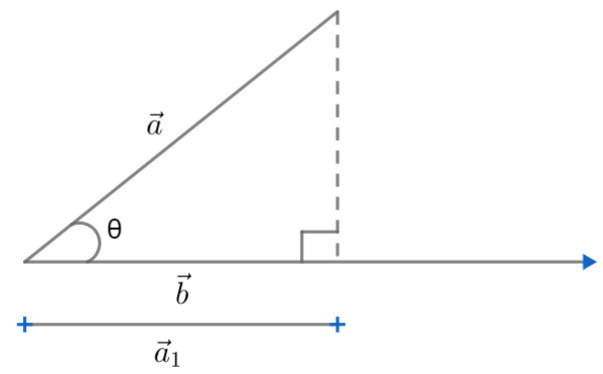
How do I find the original projection of a vector?
Answer
451.5k+ views
Hint: In this question, we need to find a formula for orthogonal projection of vector $\overrightarrow{a}$ on the vector $\overrightarrow{b}$. For this we will first understand the orthogonal projection with the help of diagrams. Then we will use trigonometric relations in the triangle formed to find the length of projection. After that, we will simply find the length and the formula required. We will use $\overrightarrow{a}\cdot \overrightarrow{b}=\left| \overrightarrow{a} \right|\left| \overrightarrow{b} \right|\cos \theta $.
Complete step by step answer:
Here we need to find the formula of orthogonal projection of a vector $\overrightarrow{a}$ on to the vector $\overrightarrow{b}$.
Suppose the two vectors are inclined at an angle $\theta $. So diagram looks like,

The projection of $\overrightarrow{a}$ onto $\overrightarrow{b}$ is the vector $\overrightarrow{{{a}_{1}}}$ which is formed when $\overrightarrow{a}$ forms a projection on $\overrightarrow{b}$. As we can see from the triangle formed $\overrightarrow{{{a}_{1}}}$ will be equal to $\left| \overrightarrow{a} \right|\cos \theta $.
So projection of $\overrightarrow{a}$ on $\overrightarrow{b}$ will be $\left| \overrightarrow{a} \right|\cos \theta $.
To simplify it in terms of $\overrightarrow{b}$ multiplying $\left| \overrightarrow{b} \right|$ on numerator and denominator we get,
\[\text{Scalar Projection}=\dfrac{\left| \overrightarrow{a} \right|\left| \overrightarrow{b} \right|\cos \theta }{\left| \overrightarrow{b} \right|}\].
We know that $\left| \overrightarrow{a} \right|\left| \overrightarrow{b} \right|\cos \theta $ represents the dot product between two vectors. So, we can write .... as $\overrightarrow{a}\cdot \overrightarrow{b}$.
So scalar projection becomes \[\dfrac{\overrightarrow{a}\cdot \overrightarrow{b}}{\left| \overrightarrow{b} \right|}\] where $\left| \overrightarrow{b} \right|$ represent the magnitude of $\overrightarrow{b}$.
In terms of vector notation, we can say $\text{Projection}=\dfrac{\left( \overrightarrow{a}\cdot \overrightarrow{b} \right)}{\overrightarrow{b}\cdot \overrightarrow{b}}\overrightarrow{b}$.
$\text{Vector Projection}=\left( \overrightarrow{a}\cdot \overrightarrow{b} \right)\dfrac{\overrightarrow{b}}{{{\left| \overrightarrow{b} \right|}^{2}}}$.
Note:
Students should keep in mind the formulas of vectors to solve this sum. Note that there is difference in terms, projection of $\overrightarrow{a}$ onto $\overrightarrow{b}$ and projection of $\overrightarrow{b}$ onto $\overrightarrow{a}$. Projection of $\overrightarrow{a}$ on $\overrightarrow{b}$ can be described as the shadow of $\overrightarrow{a}$ on $\overrightarrow{b}$.
Complete step by step answer:
Here we need to find the formula of orthogonal projection of a vector $\overrightarrow{a}$ on to the vector $\overrightarrow{b}$.
Suppose the two vectors are inclined at an angle $\theta $. So diagram looks like,

The projection of $\overrightarrow{a}$ onto $\overrightarrow{b}$ is the vector $\overrightarrow{{{a}_{1}}}$ which is formed when $\overrightarrow{a}$ forms a projection on $\overrightarrow{b}$. As we can see from the triangle formed $\overrightarrow{{{a}_{1}}}$ will be equal to $\left| \overrightarrow{a} \right|\cos \theta $.
So projection of $\overrightarrow{a}$ on $\overrightarrow{b}$ will be $\left| \overrightarrow{a} \right|\cos \theta $.
To simplify it in terms of $\overrightarrow{b}$ multiplying $\left| \overrightarrow{b} \right|$ on numerator and denominator we get,
\[\text{Scalar Projection}=\dfrac{\left| \overrightarrow{a} \right|\left| \overrightarrow{b} \right|\cos \theta }{\left| \overrightarrow{b} \right|}\].
We know that $\left| \overrightarrow{a} \right|\left| \overrightarrow{b} \right|\cos \theta $ represents the dot product between two vectors. So, we can write .... as $\overrightarrow{a}\cdot \overrightarrow{b}$.
So scalar projection becomes \[\dfrac{\overrightarrow{a}\cdot \overrightarrow{b}}{\left| \overrightarrow{b} \right|}\] where $\left| \overrightarrow{b} \right|$ represent the magnitude of $\overrightarrow{b}$.
In terms of vector notation, we can say $\text{Projection}=\dfrac{\left( \overrightarrow{a}\cdot \overrightarrow{b} \right)}{\overrightarrow{b}\cdot \overrightarrow{b}}\overrightarrow{b}$.
$\text{Vector Projection}=\left( \overrightarrow{a}\cdot \overrightarrow{b} \right)\dfrac{\overrightarrow{b}}{{{\left| \overrightarrow{b} \right|}^{2}}}$.
Note:
Students should keep in mind the formulas of vectors to solve this sum. Note that there is difference in terms, projection of $\overrightarrow{a}$ onto $\overrightarrow{b}$ and projection of $\overrightarrow{b}$ onto $\overrightarrow{a}$. Projection of $\overrightarrow{a}$ on $\overrightarrow{b}$ can be described as the shadow of $\overrightarrow{a}$ on $\overrightarrow{b}$.
Recently Updated Pages
Glucose when reduced with HI and red Phosphorus gives class 11 chemistry CBSE

The highest possible oxidation states of Uranium and class 11 chemistry CBSE

Find the value of x if the mode of the following data class 11 maths CBSE

Which of the following can be used in the Friedel Crafts class 11 chemistry CBSE

A sphere of mass 40 kg is attracted by a second sphere class 11 physics CBSE

Statement I Reactivity of aluminium decreases when class 11 chemistry CBSE

Trending doubts
10 examples of friction in our daily life

Difference Between Prokaryotic Cells and Eukaryotic Cells

One Metric ton is equal to kg A 10000 B 1000 C 100 class 11 physics CBSE

State and prove Bernoullis theorem class 11 physics CBSE

What organs are located on the left side of your body class 11 biology CBSE

Define least count of vernier callipers How do you class 11 physics CBSE




